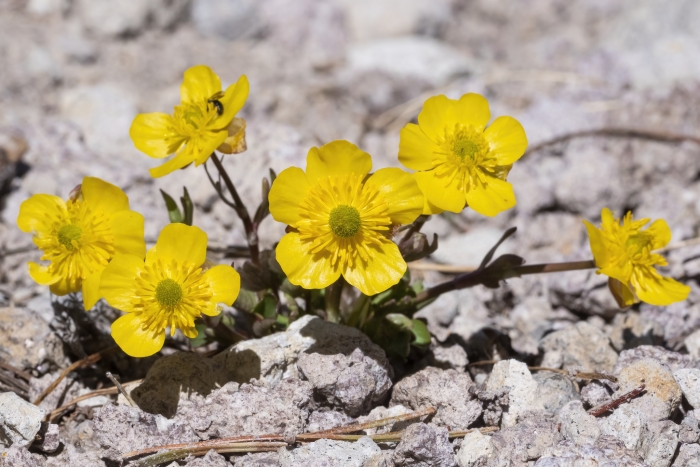Eschscholtz’s Buttercup
(Ranunculus eschscholtzii)
Eschscholtz’s Buttercup (Ranunculus eschscholtzii)
/
/

© Sam Eberhard
CC BY 4.0
Image By:
© Sam Eberhard
Recorded By:
Copyright:
CC BY 4.0
Copyright Notice:
Photo by: © Sam Eberhard | License Type: CC BY 4.0 | License URL: http://creativecommons.org/licenses/by/4.0/ | Uploader: bigsam | Publisher: iNaturalist |
























Estimated Native Range
Summary
Ranunculus eschscholtzii, commonly known as Eschscholtz’s buttercup, is a perennial herb that thrives in the alpine and subalpine zones of western North America, ranging from Arctic northwestern Canada and Alaska to California and New Mexico. It is particularly adapted to open, rocky habitats, including meadows, talus on high mountain slopes, and other areas with well-drained soils. This species typically produces one or more erect stems reaching heights of 10 to 20 inches, with foliage that is hairless and sometimes exhibits a waxy coating, an adaptation to its harsh native environment.
Eschscholtz’s buttercup is notable for its shiny yellow flowers that bloom from late spring to early summer, with each flower displaying five to eight petals that can be up to 1 inch long. The flowers are showy and attract a variety of pollinators. The fruit is an achene, which forms in a cluster of 17 or more, and is less commonly noticed. In cultivation, this buttercup is appreciated for its bright flowers and its ability to thrive in rock gardens or alpine garden settings. It requires well-drained soil, moderate water, and full sun to part shade conditions. While it is not commonly used in large-scale plantings, it can be a charming addition to specialized garden areas where its natural beauty can be showcased.CC BY-SA 4.0
Eschscholtz’s buttercup is notable for its shiny yellow flowers that bloom from late spring to early summer, with each flower displaying five to eight petals that can be up to 1 inch long. The flowers are showy and attract a variety of pollinators. The fruit is an achene, which forms in a cluster of 17 or more, and is less commonly noticed. In cultivation, this buttercup is appreciated for its bright flowers and its ability to thrive in rock gardens or alpine garden settings. It requires well-drained soil, moderate water, and full sun to part shade conditions. While it is not commonly used in large-scale plantings, it can be a charming addition to specialized garden areas where its natural beauty can be showcased.CC BY-SA 4.0
Plant Description
- Plant Type: Herb
- Height: 0.5-2 feet
- Width: 0.5-1 feet
- Growth Rate: Moderate
- Flower Color: Yellow
- Flowering Season: Spring, Summer, Fall
- Leaf Retention: Deciduous
Growth Requirements
- Sun: Full Sun, Part Shade
- Water: Medium
- Drainage: Fast, Medium
Common Uses
Bird Garden, Butterfly Garden, Low Maintenance, Rock Garden, Water Garden
Natural Habitat
Alpine and subalpine zones of western North America
Other Names
Common Names: Largeflower Buttercup, Alpine Buttercup, Spruce-Fir Buttercup, Mountain Buttercup, Subalpine Buttercup
Scientific Names: , Ranunculus eschscholtzii, Ranunculus eschscholtzii subsp. asiaticus, Ranunculus eschscholtzii subsp. hultenianus, Ranunculus eschscholtzii var. asiaticus, Ranunculus eschscholtzii var. helleri, Ranunculus eschscholtzii var. hookeri, Ranunculus eschscholtzii var. hultenianus, Ranunculus eschscholtzii var. typicus, Ranunculus helleri
GBIF Accepted Name: